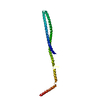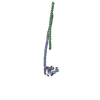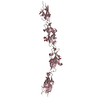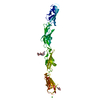+ Open data
Open data
- Basic information
Basic information
| Entry | Database: PDB / ID: 7abk | ||||||
|---|---|---|---|---|---|---|---|
| Title | Helical structure of PspA | ||||||
 Components Components | Chloroplast membrane-associated 30 kD protein | ||||||
 Keywords Keywords | LIPID BINDING PROTEIN / PspA / IM30 / Vipp1 /  ESCRT-III / helical reconstruction / ESCRT-III / helical reconstruction /  Cryo-EM / membrane remodeling Cryo-EM / membrane remodeling | ||||||
| Function / homology | PspA/IM30 / PspA/IM30 family / Chloroplast membrane-associated 30 kD protein Function and homology information Function and homology information | ||||||
| Biological species |  | ||||||
| Method |  ELECTRON MICROSCOPY / helical reconstruction / ELECTRON MICROSCOPY / helical reconstruction /  cryo EM / Resolution: 3.6 Å cryo EM / Resolution: 3.6 Å | ||||||
 Authors Authors | Junglas, B. / Huber, S.T. / Mann, D. / Heidler, T. / Clarke, M. / Schneider, D. / Sachse, C. | ||||||
| Funding support |  Germany, 1items Germany, 1items
| ||||||
 Citation Citation |  Journal: Cell / Year: 2021 Journal: Cell / Year: 2021Title: PspA adopts an ESCRT-III-like fold and remodels bacterial membranes. Authors: Benedikt Junglas / Stefan T Huber / Thomas Heidler / Lukas Schlösser / Daniel Mann / Raoul Hennig / Mairi Clarke / Nadja Hellmann / Dirk Schneider / Carsten Sachse /  Abstract: PspA is the main effector of the phage shock protein (Psp) system and preserves the bacterial inner membrane integrity and function. Here, we present the 3.6 Å resolution cryoelectron microscopy ...PspA is the main effector of the phage shock protein (Psp) system and preserves the bacterial inner membrane integrity and function. Here, we present the 3.6 Å resolution cryoelectron microscopy (cryo-EM) structure of PspA assembled in helical rods. PspA monomers adopt a canonical ESCRT-III fold in an extended open conformation. PspA rods are capable of enclosing lipids and generating positive membrane curvature. Using cryo-EM, we visualized how PspA remodels membrane vesicles into μm-sized structures and how it mediates the formation of internalized vesicular structures. Hotspots of these activities are zones derived from PspA assemblies, serving as lipid transfer platforms and linking previously separated lipid structures. These membrane fusion and fission activities are in line with the described functional properties of bacterial PspA/IM30/LiaH proteins. Our structural and functional analyses reveal that bacterial PspA belongs to the evolutionary ancestry of ESCRT-III proteins involved in membrane remodeling. | ||||||
| History |
|
- Structure visualization
Structure visualization
| Movie |
 Movie viewer Movie viewer |
|---|---|
| Structure viewer | Molecule:  Molmil Molmil Jmol/JSmol Jmol/JSmol |
- Downloads & links
Downloads & links
- Download
Download
| PDBx/mmCIF format |  7abk.cif.gz 7abk.cif.gz | 45.1 KB | Display |  PDBx/mmCIF format PDBx/mmCIF format |
|---|---|---|---|---|
| PDB format |  pdb7abk.ent.gz pdb7abk.ent.gz | 32 KB | Display |  PDB format PDB format |
| PDBx/mmJSON format |  7abk.json.gz 7abk.json.gz | Tree view |  PDBx/mmJSON format PDBx/mmJSON format | |
| Others |  Other downloads Other downloads |
-Validation report
| Arichive directory |  https://data.pdbj.org/pub/pdb/validation_reports/ab/7abk https://data.pdbj.org/pub/pdb/validation_reports/ab/7abk ftp://data.pdbj.org/pub/pdb/validation_reports/ab/7abk ftp://data.pdbj.org/pub/pdb/validation_reports/ab/7abk | HTTPS FTP |
|---|
-Related structure data
| Related structure data |  11698MC M: map data used to model this data C: citing same article ( |
|---|---|
| Similar structure data |
- Links
Links
- Assembly
Assembly
| Deposited unit | 
|
|---|---|
| 1 |
|
- Components
Components
| #1: Protein | Mass: 28260.816 Da / Num. of mol.: 1 Source method: isolated from a genetically manipulated source Source: (gene. exp.)  Strain: PCC 6803 / Kazusa / Gene: im30 / Plasmid: pRSET6 / Production host:   Escherichia coli BL21(DE3) (bacteria) / References: UniProt: P74717 Escherichia coli BL21(DE3) (bacteria) / References: UniProt: P74717 |
|---|
-Experimental details
-Experiment
| Experiment | Method:  ELECTRON MICROSCOPY ELECTRON MICROSCOPY |
|---|---|
| EM experiment | Aggregation state: FILAMENT / 3D reconstruction method: helical reconstruction |
- Sample preparation
Sample preparation
| Component | Name: Helical filament assembly of PspA / Type: ORGANELLE OR CELLULAR COMPONENT / Entity ID: all / Source: RECOMBINANT |
|---|---|
| Molecular weight | Value: 0.025 MDa / Experimental value: NO |
| Source (natural) | Organism:  |
| Source (recombinant) | Organism:   Escherichia coli BL21(DE3) (bacteria) / Plasmid Escherichia coli BL21(DE3) (bacteria) / Plasmid : pRSET6 : pRSET6 |
| Buffer solution | pH: 7.6 |
| Buffer component | Conc.: 10 mM / Name: Sodium Phosphate / Formula: NaH2PO4 |
| Specimen | Conc.: 7.9 mg/ml / Embedding applied: NO / Shadowing applied: NO / Staining applied : NO / Vitrification applied : NO / Vitrification applied : YES : YES |
| Specimen support | Details: Pelco easiGlow / Grid material: COPPER / Grid mesh size: 200 divisions/in. / Grid type: Quantifoil R1.2/1.3 |
Vitrification | Instrument: FEI VITROBOT MARK IV / Cryogen name: ETHANE / Humidity: 90 % / Chamber temperature: 283.15 K / Details: Quantifoil R1.2/1.3 Cu200 grids |
- Electron microscopy imaging
Electron microscopy imaging
| Microscopy | Model: TFS TALOS |
|---|---|
| Electron gun | Electron source : :  FIELD EMISSION GUN / Accelerating voltage: 200 kV / Illumination mode: FLOOD BEAM FIELD EMISSION GUN / Accelerating voltage: 200 kV / Illumination mode: FLOOD BEAM |
| Electron lens | Mode: BRIGHT FIELD Bright-field microscopy / Nominal magnification: 100000 X / Nominal defocus max: 2300 nm / Nominal defocus min: 200 nm / Cs Bright-field microscopy / Nominal magnification: 100000 X / Nominal defocus max: 2300 nm / Nominal defocus min: 200 nm / Cs : 2.7 mm / Alignment procedure: COMA FREE : 2.7 mm / Alignment procedure: COMA FREE |
| Specimen holder | Cryogen: NITROGEN / Specimen holder model: FEI TITAN KRIOS AUTOGRID HOLDER |
| Image recording | Electron dose: 50 e/Å2 / Film or detector model: GATAN K3 BIOQUANTUM (6k x 4k) |
| EM imaging optics | Energyfilter name : GIF Bioquantum : GIF Bioquantum |
- Processing
Processing
| Software | Name: PHENIX / Version: 1.16_3549: / Classification: refinement | ||||||||||||||||||||||||||||||||
|---|---|---|---|---|---|---|---|---|---|---|---|---|---|---|---|---|---|---|---|---|---|---|---|---|---|---|---|---|---|---|---|---|---|
| EM software |
| ||||||||||||||||||||||||||||||||
CTF correction | Type: PHASE FLIPPING AND AMPLITUDE CORRECTION | ||||||||||||||||||||||||||||||||
| Helical symmerty | Angular rotation/subunit: 35.32 ° / Axial rise/subunit: 2.94 Å / Axial symmetry: C1 | ||||||||||||||||||||||||||||||||
| Particle selection | Num. of particles selected: 5604 | ||||||||||||||||||||||||||||||||
3D reconstruction | Resolution: 3.6 Å / Resolution method: FSC 0.143 CUT-OFF / Num. of particles: 19900 / Algorithm: FOURIER SPACE / Symmetry type: HELICAL | ||||||||||||||||||||||||||||||||
| Atomic model building | Protocol: AB INITIO MODEL / Space: REAL | ||||||||||||||||||||||||||||||||
| Refine LS restraints |
|
 Movie
Movie Controller
Controller












 PDBj
PDBj